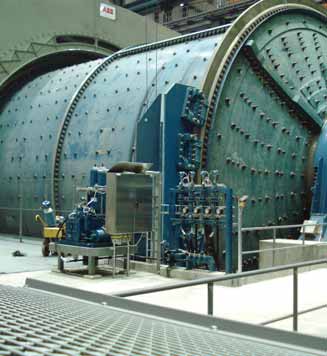Mill Drives and Brakes Muscle Up
Recent years have seen a trend toward fewer comminution
machines per process line, particularly as grinding mills have
increased considerably in size. Today, autogenous grinding
(AG) mills as large as 40-ft in diameter with motor power in
excess of 20 MW are being ordered and installed as producers
look for higher production and economy of scale in their
process plants. Semiautogenous grinding (SAG) mills up to
44-ft diameter with 35-MW gearless mill drives (GMDs) are
available.
In January, for example, a 1,210-ton AG mill—considered
to be the largest ever built—was shipped from the CITIC
Heavy Machinery plant in China to the Sino Iron project in
Australia. The mill, the first of five to be installed at Sino, has
a diameter of 12.2 m (40 ft), is 15 m (49.2 ft) long, and will
be powered by a 28-MW Siemens GMD. Siemens also supplied
the gearless drives for a 36-ft SAG mill with a rated
power of 15 MW and a 26-ft ball mill with 15.5 MW of rated
power recently installed at the Minera Los Pelambres copper
operation in Chile.
These large, powerful gearless drive mills require improved
control systems, ranging from the sophisticated controllers
that monitor and protect the mill’s ringmotor and frequencyconversion
electronics from electrical damage, to the braking
systems that provide safe, controlled stops. And, as these
larger units replace multiple smaller mills and are often
installed at sites in remote locations, reliability and operational
stability become increasingly critical factors in achieving
production targets.
In order to improve mill performance ABB, in 2009,
replaced its PSR GMD controller with the AC 800PEC version,
which it has used since 2001 in converters and drives for
power transmission, excitation systems for motors and generators,
and wind power applications. This upgrade, according
to the company, provides a number of improvements in reliability,
service availability and hardware simplification, as well
as faster testing and commissioning procedures.
One of the principal improvements offered by the new controller
is “power ride-through.” If the main power supply voltage
drops below 85% of normal, for example, or if a phase angle
deviation is detected, the controller can activate the ridethrough
function, which immediately ramps down the stator
current to zero, followed by thyristor pulse blocking. The rotating
mass of the mill load and the rotor inertia keep the mill
turning during the ride-through period, which is adjustable from
0 to 1 second, with 200 ms the default. As long as mill speed
remains above a specified level during the ride-through, the system
will release the thyristor pulses and will power the mill
slowly up to the previous speed when supply voltage returns. If
the voltage doesn’t recover within the specified interval or if
mill speed drops too much, a fast shutdown is performed and
the system is disconnected from the electrical network.
Stopping large mills—either as part of a planned event or in
an emergency—also requires upgraded equipment. U.K.-based
Twiflex Ltd., which specializes in providing advanced braking
technology for industrial applications, recently delivered their
largest grinding mill braking system to Metso Minerals
Industries, Inc. for installation on gearless grinding mills
installed at Boliden Mineral’s Aitik mine in northern Sweden,
the largest open-pit copper mine in Europe. An expansion program
(Aitik 36) will raise production capacity from 18 million
mt/y to 36 million mt/y when completed this year. The project
includes a wide range of processing equipment at the new Aitik
concentrator, ranging from the large grinding mills to 52
Outotec TankCell flotation machines, three pressure filters and
molybdenum and gold recovery circuits.
At the Aitik concentrator, two 22.5-MW GMDs supplied by
ABB power 38-ft (11.6-m) diameter x 45-ft (13.7-m) long AG
grinding mills.
Twiflex said its braking system is designed specifically for
grinding mill installations and provides both static and
dynamic braking functions. In static operation, the braking
system holds the mill motionless during liner replacement and
general mill maintenance. For dynamic operation, the system
can operate in two modes, stopping the mill from full speed
in an emergency or providing inching/creeping capability in
the event of bearing lubrication problems or power failures.
These modes, respectively, require steady, controlled application
of the brakes as well as quick activation to provide the
accurate stoppage required by the operator.
For the Aitik project, Twiflex supplied eight VMS-DP brake
calipers with pedestals plus a hydraulic power pack for each
mill. The VMS-DP caliper has an adjustable braking force
from 590 to 737 kN and is a floating-spring applied, hydraulically
retracted brake suitable for disc/flange thicknesses from
117 mm to 130 mm. The brake can be used on installations
with a braking path of at least 7.6-m outside diameter or larger,
and 7-m inside diameter. The hydraulic power pack offers
versatile brake control as it allows both local and remote operation
for inching and creeping duties through a control panel.
According to Twiflex, the braking systems installed at Aitik
can generate up to 38 MNm braking torque for each mill, acting
on a 12.97-m flange diameter. The VMS-DP calipers
weigh 1.85 mt each and are able to deliver 940 kN clamping
force. The system is able to stop a mill in less than 2 seconds.


